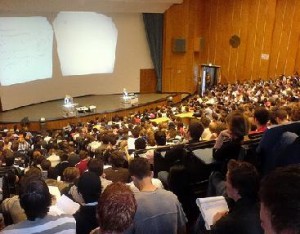College’s Overcrowded 0
Two-Year Colleges, Swamped, No Longer Welcome All
Sonja Taylor applied to LaGuardia Community College this summer with every expectation of being admitted. She planned to study business, bringing her closer to her dream of owning a restaurant.
But her application arrived in August, after the college had closed the floodgates because of a surge of interest from prospective students. So Ms. Taylor, 20, became one of thousands of students shut out this fall as most of New York City’s community colleges were forced to abandon their all-are-welcome admissions policies for the first time.
 “Enrollment has been growing steadily, but this was a tidal wave for us this fall,†said the college’s president, Gail O. Mellow, pointing out that the student body had risen by almost 50 percent in the past decade. “I’ve never seen anything like this. We used to pretty much be an open door.â€
“Enrollment has been growing steadily, but this was a tidal wave for us this fall,†said the college’s president, Gail O. Mellow, pointing out that the student body had risen by almost 50 percent in the past decade. “I’ve never seen anything like this. We used to pretty much be an open door.â€
Historically, the city’s six community colleges, which are part of the City University of New York, have taken applications until about a week before the start of classes, allowing time for students to apply for financial aid, get immunized and register for classes.
But this year, all but one of them had to close admissions earlier.
LaGuardia stopped accepting applications on July 30. The Borough of Manhattan Community College stopped in late June, while Bronx, Hostos and Queensborough Community Colleges cut off applications in the first half of August. Kingsborough Community College did not change the application period.
Applications to the community colleges for the 2010 spring semester are up 19 percent from the same time last year. LaGuardia, which has 52,000 students, including 17,500 degree-seeking students, has imposed a Nov. 15 deadline for spring applications.
For years the colleges have offered an affordable avenue to higher education for low-income students, many of them the first in their families to attend college. The only requirements are a high school or graduate-equivalency diploma. So the early cutoffs caught many, including Ms. Taylor, off guard.
“During these times I need some type of college degree in order to get a good job,†she said. “I was disappointed because it’s a really good college and it’s right there. It’s close to my home.â€
The State University of New York also saw a spike in applications to its community colleges, with Suffolk County Community College reporting a 20 percent jump in enrollment over last fall. The two-year colleges did not restrict enrollments across the board, but some limited registrations in certain programs like nursing, said Megan Galbraith, a SUNY representative. Many colleges increased class sizes and added class sections.
Across the country, many community colleges have felt similar pressures. The battered economy drove many workers back to school to retool their skills, while others have eschewed a four-year degree in favor of a more affordable two-year program.
Education experts say that the Obama administration also put the nation’s 1,200 community colleges on the radars of more students this summer. Praising the colleges’ role in developing the work force, President Obama called for $12 billion in new federal financing for community colleges and set a goal of five million more graduates by 2020.
While such money would go a long way toward meeting that goal, for now community colleges, like all publicly financed colleges, are struggling with budget cuts just as they face the greatest demands.
“The community college is a second-chance institution for the country,†said Patrick M. Callan, president of the National Center for Public Policy and Higher Education. “Most people would agree that this is not a good time in terms of the economic competitiveness of the country to be turning people away.â€
Last month, Gov. Paterson proposed midyear budget cuts for many state agencies. Higher education would be hit especially hard. CUNY’s chancellor, Matthew Goldstein, said the cuts would result in a “deficiency of about $9 million in operating aid†to the community colleges.
Dr. Goldstein said he faced a “moral dilemmaâ€: turning away students who may have nowhere else to go, or continually expanding enrollments but jeopardizing quality.
At the Borough of Manhattan Community College, the president, Antonio Pérez, said the decision to close enrollment on June 22, which the admissions office announced on its Web site a week earlier, had been difficult. “It’s almost like trying to stop a large ship in the middle of the ocean,†he said. “I expect we will be turning away students next semester as well.â€
A new community college that CUNY has been planning for a few years is still on track. But the college, which is scheduled to open in 2011 or 2012 on the West Side of Manhattan with only about 3,000 students, would not do much to alleviate overcrowding in the rest of the system.
At LaGuardia, signs abound of a college under stress. Classes now begin as early as 6:45 a.m. The line for the 170 computer workstations in the library can snake around the stacks at lunchtime, and the wait sometimes stretches to 45 minutes.
Still, Ms. Taylor, who plans to apply for the spring semester, is eager to join the throng. She is now working on commission as a telemarketer, making cold calls for a company selling credit card terminals. “I can make 200 calls and probably sell four products the whole day,†she said.
November 12, 2009
